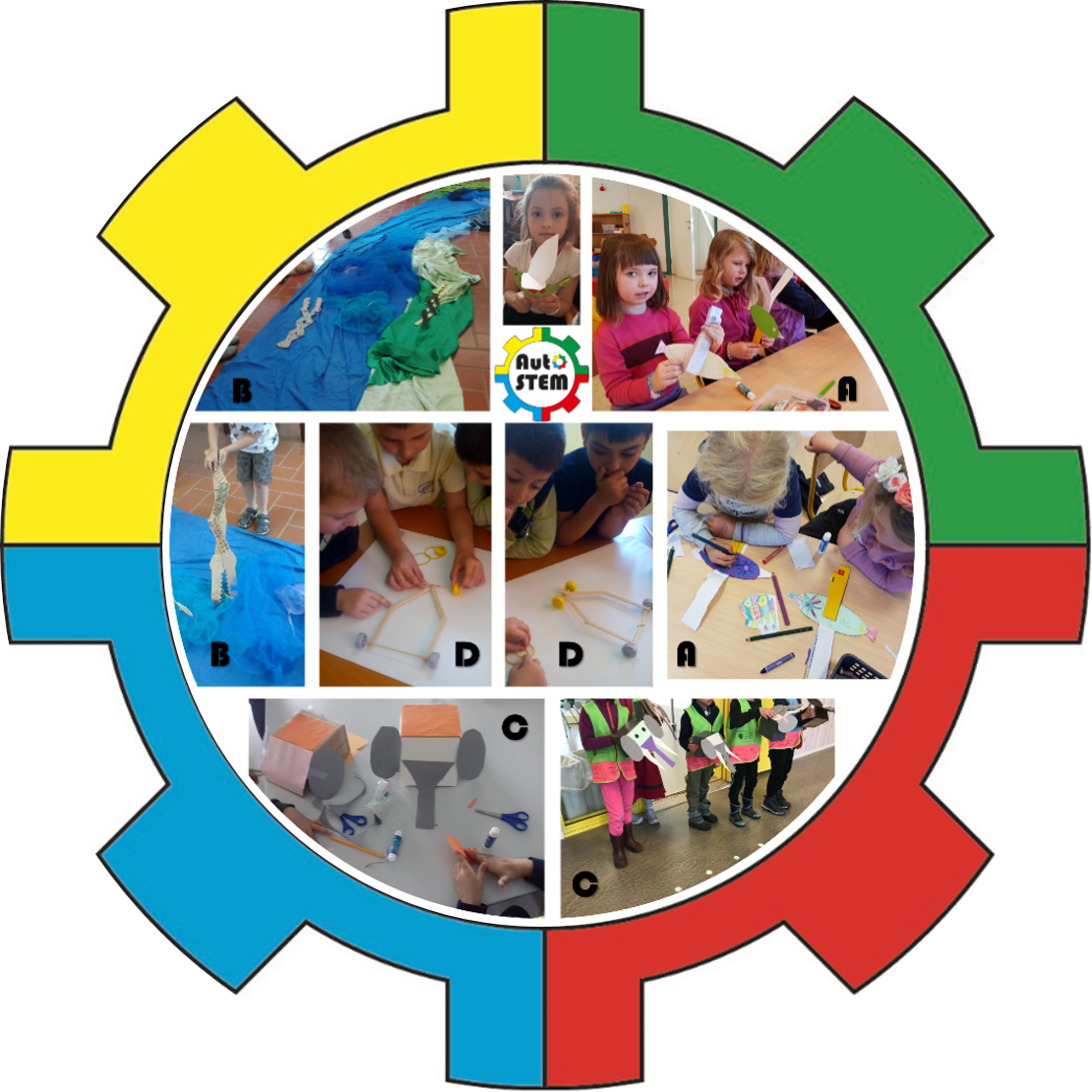Below we look in a little detail at the AutoSTEM Automata so you can understand what each one can teach, who to and what are the main components you will need to build it.
Each automaton comes with a step by step guide, video tutorials on construction and videos of the automaton being used. Where appropriate there are also templates that can be printed and used in the construction.
In the table you will find a link to a brief summary about each automata to help you further understand. They can be found below the table. We detail the suggested age level, subjects that are included in the construction or use of each automata ( in the step by step guides you will find specifics on how each automata can be used to teach STEM) , the propulsion method used to make the automata move and the materials that you will need to make the automata.
Summary Table of AutoSTEM automata
| Automata | Age level | Subjects covered | Propulsion method | Construction Materials |
| Acrobat Link | 4 – 7 | Physics, mechanisms, biology | Manual, turning | Coloured paper, cardboard, wooden skewers, split pins |
| Balloon boat/ Amphicar Link | 4 – 7 | Physics, mechanisms, transfer of energy | Breath | Drink carton, skewers, bottle caps, straws, balloon, sticky tape |
| Balloon Car Link | 5-7 | Mathematics, physics and mechanisms | Breath | Thick paper, skewers, bottle caps, straws, balloon, sticky tape |
| Catapult Link | 4 – 8 | Mathematics, physics and mechanisms | Manual | Wooden sticks (for ice cream), rubber band, bottle cap, split pin |
| Colour Spinning Disk Link | 4 – 7 | Mathematics, physics and mechanisms | Manual | Paper, skewer, colouring materials |
| Dancing Doll Link | 4 – 7 | Mathematics, physics and mechanisms. biology | Manual | Coloured paper, foam rubber, cardboard, skewers, straws |
| Drawbridge Link | 5-8 | Physics and mechanisms, engineering, mathematics | Manual | Thick cardboard, string, sticky tape, skewers |
| JellyBird Link | 4 – 7 | Mechanisms, mathematics | Manual | Paper, thin cardboard |
| Snapping Crocodile Link | 4 – 7 | Mechanisms, engineering, mathematics | Manual | Cardboard, split pins |
| Elevator Link | 4 – 7 | Mechanisms, engineering, mathematics | Manual | Carton, skewer, wheel or disc, matchbox, Sticky tape, String |
| Returning tin can Link | 4 – 7 | Physics engineering, mathematics | Manual | Cylinder shaped box or bottle. 9V battery, Sticky tape, Scissors, Rubber band, Paper clips |
The AutoSTEM automata in detail
Each automata has it’s own page on the website that includes a Teachers Step by Step guide, videos, templates (if appropriate) and description, Below we summarise that information as an introduction.
The Acrobat

The Acrobat is made from paper, wooden skewers, corks/plastic discs and split pins that makes acrobatic movements when the linkages are complete and a manual rotation movement is made. Step by step guide
Learning goals
When constructing the Acrobat several learning goals can be achieved:
- To learn about physics and mechanisms, in particular, linkages.
- To develop engineering competences of analysis and construction.
- To learn mathematical concepts within the construction and assembly process, including shapes and numbers.
- To learn biology concepts about parts of the human body.
- Other soft-learning goals can be included; problem solving and creativity.
Balloon boat and Amphicar

The Amphicar is a toy that is a boat and a car at the same time. When building it, the children can stop when it is a boat or continue to make a car that can still be used as a boat like the classical Amphicar. Step by step guide
Learning goals
- To practice measuring
- To use a ruler to draw a straight line (or for measuring)
- To learn about physics and mechanisms
- To develop engineering competencies of analysis and construction.
- To learn mathematical concepts within the construction and assembly process, including shapes and numbers.
- Other soft-learning goals can be included; problem solving and creativity.
Balloon Car
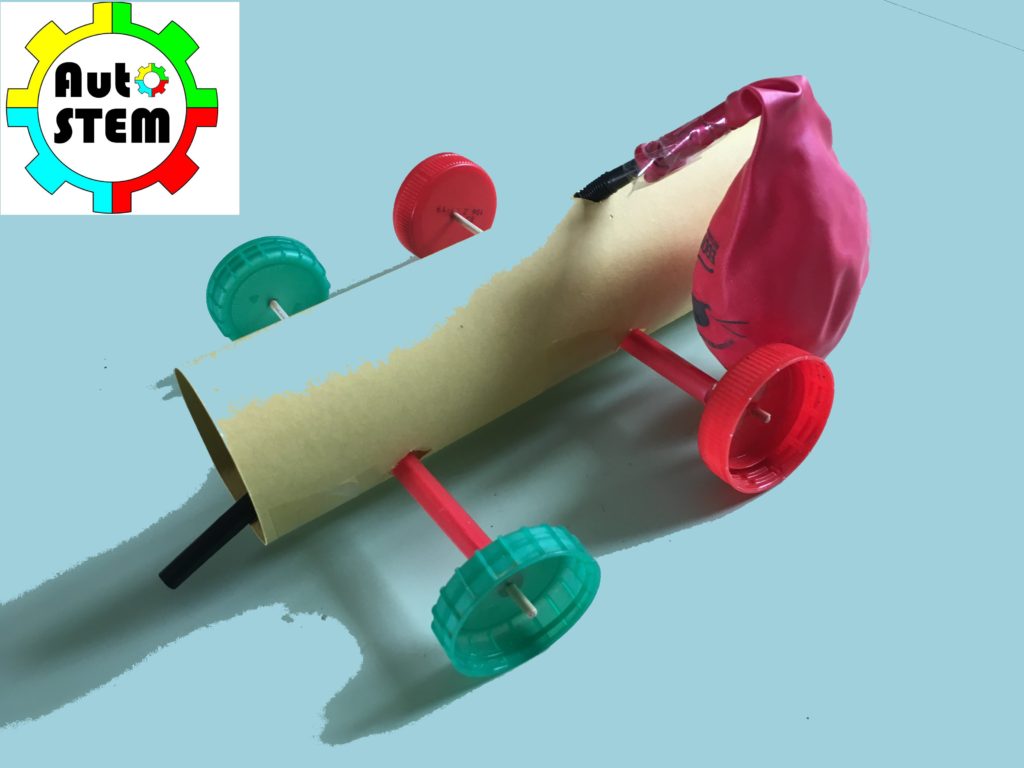
The Balloon car is a toy car made from standard cardboard, straws, wooden skewers, bottle tops and a balloon. It will move on its own when the balloon is inflated. Step by step guide
Learning goals
- To practice measuring and using a ruler
- An introduction to simple fractions
- To learn about physics and mechanisms
- To develop engineering competences of analysis and construction.
- To learn mathematical concepts within the construction and assembly process, including shapes and numbers.
- Other soft-learning goals can be included; problem solving and creativity.
Catapult
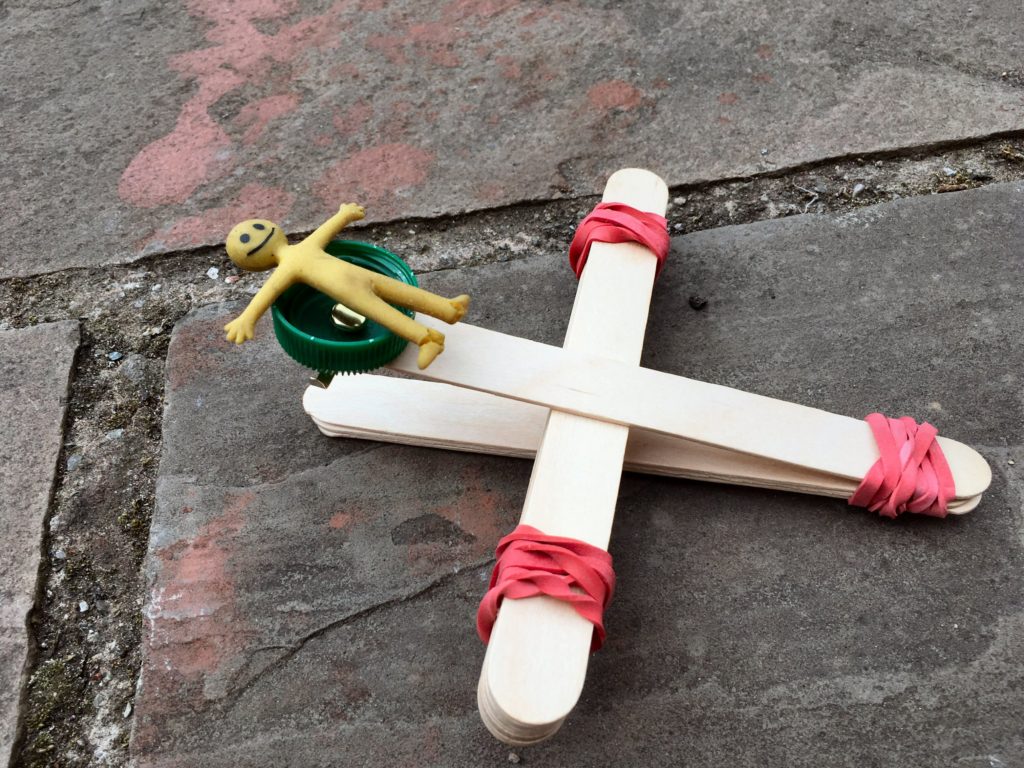
The Catapult is a toy that is extremely simple to make. It has the capacity to fire a small, lightweight projectile (payload) a short distance. The Catapult is made from wooden sticks that are used for ice cream or for naming seeds in a garden, elastic bands, a bottle top and glue or a split pin. It can be used indoors or outside. Step by step guide
Learning goals
- To learn Mathematics including counting, addition, use of table, measuring. Simple statistics
- To learn about physics and mechanisms
- To develop engineering competencies of analysis and construction.
- Other soft-learning goals can be included; problem solving and creativity.
Colour Spinning Disk

The Colour Spinning Disk is based on a physics experiment, usually called the Newton disk. This is a rotating disk whose surface is divided in to different colours, that appear to be white or grey when it is spun quickly Step by step guide
Learning goals
To learn about Physics
- Properties of light and colour.
- History of science
- Mechanisms – rotation mechanisms
- Forms of energy -mechanical and wind.
- Perception mechanisms (persistence of vision).
To learn Mathematical concepts
- Shapes, circles and triangles, numbers, and equal parts
- To develop engineering competences
- To develop competences of analysis and construction.
The Dancing Doll
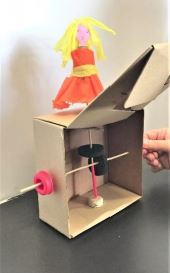
The Dancing doll is a paper doll that fits on the top of a box. It turns around when a hand crank is activated. Inside the box there is a mechanism that makes the motion. Step by step guide
Learning goals
- To learn about physics and mechanisms,
- To develop engineering competences of analysis and construction.
- To learn mathematical concepts within the construction and assembly process, including shapes and numbers.
- To learn biology concepts about parts of the human body.
- Other soft-learning goals can be included; problem solving and creativity.
The Drawbridge

The Drawbridge is a toy bridge that can be raised to allow passage of a ship having masts too tall to pass under or to defend the entrance of a medieval castle. It is made from double-wall corrugated cardboard (from a big parcel), a wooden skewer, and string. Step by step guide
Learning goals
- To learn about physics and mechanisms
- To develop engineering competencies of analysis and construction.
- To learn mathematical concepts within the construction and assembly
- process, including shapes and numbers.
- To practice measuring
- Other soft-learning goals can be included; problem solving and creativity.
The JellyBird

The construction and use of the Jellybird allows the teaching of a number of mathematical concepts within the construction and assembly process. It is constructed from paper and cardboard and templates are available on the website for printing and is suitable for the youngest children. Step by step guide
Learning goals
- To develop engineering competencies of analysis and construction.
- To learn mathematical concepts within the construction and assembly process, including shapes and numbers
- Other soft-learning goals can be included; problem solving and creativity.
Snapping Crocodile

A cardboard moving toy, which makes use of the scissors arm mechanism. It has the face of a crocodile but can be changed into a dinosaur or any other animal. With the help of the scissors arms, the child can make the crocodile’s mouth open and close, snap, pinch, and grasp light objects. It allows children to analyse the mechanism and use it as a toy while gaining educational insights. Step by step guide
Learning goals
- To learn about physics and mechanisms, in particular, linkages.
- To develop engineering competencies of analysis and construction.
- To learn mathematical concepts within the construction and assembly process, including patterns, shapes and numbers.
- To learn biology concepts about the animal and its environment
- Other soft-learning goals can be included like problem-solving and creativity.
Elevator

The elevator is a small house made from a milk or juice carton. The house contains a winch that is used to lift and lower an elevator. It has two open doors, one door on the ground floor and one on the top floor on the opposite side of the building. The toy can be used to play Kim’s game. Kim’s game is an exercise in observation, memory and classification. There are also many different possibilities for the children to explore and play with the mechanical mechanisms used in this toy. Step by step guide
Learning goals
- To learn about physics and mechanisms
- To develop engineering competencies of analysis and construction.
- To learn mathematical concepts within the construction and assembly process, including shapes, geometric terms and numbers.
- To practice measuring
- To train observational skills
- To learn classification
- Other soft-learning goals can be included; problem solving and creativity.
Returning tin can
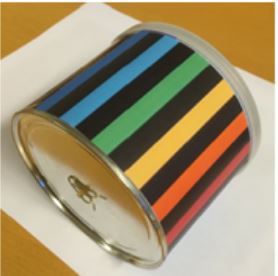
The machine consists of a rubber band that is twisted inside a cylinder shaped tin can. As the cylinder rolls across the floor, the twisted rubber band will make the can roll in the opposite direction as soon as it stops. Kinetic energy of the rolling cylinder is transformed to elastic energy stored by the rubber band and then back to kinetic energy as the cylinder rolls in the opposite direction. Step by step guide
Learning goals
- To learn about physics and energy sources, in particular, kinetic energy and elastic energy. It can also be used to learn about energy transformation, namely transferring the kinetic energy in the moving cylinder into elastic energy stored in the rubber band and then back to kinetic energy as the cylinder starts rolling back.
- For the youngest children the main goal is to let them experience the phenomena of energy transformation rather than learning abstract concepts like kinetic and elastic energy
- To develop engineering competences of analysis and construction.
- To learn mathematical concepts within the construction and assembly process, including shapes.
- The machine is partly made of reusable material (the box). This is an opportunity to raise the awareness of sustainability and reusability.
- Other soft-learning goals can be included; problem solving and creativity.
Other resources
AutoSTEM has also made additional resources that you can use in your classes or as background to help you understand the project further and help you evaluate the effectiveness with your students.
The project is also producing case studies so you can see how it has been implemented in a number of differing scenarios.
The first thing you can read is the Step by Step teacher guide that is available in the 5 project languages with links, below:
Step by step teacher guide in English
Steg for steg lærerveiledning in Norwegian
Стъпка по стъпка Ръководство за учителя in Bulgarian
Guida per gli insignanti in Italian
Guião passo a passo para professores in Portuguese
In these guides you will find sections on:
- Automata for STEM
- Theoretical framework
- The pedagogical concept
- Key concepts for automata construction
- References
You will also find resources for planning and reflection that include:
- Guide to scheduling and planning a workshop with children
- Evaluating a children’s workshop
- Reporting a children’s workshop
- Certification
There are a number of helpful templates, questionnaires and certificates found in the appendixes of this document that you can print if you need, these include:
- Template for planning a workshop
- Parental permission form
- Attendance sheet
- Logbook for children
- Pre-questionnaire for children 4-5 years
- Pre-questionnaire for children 6-7 years
- Pre-workshop interview with children
- Observation guide
- Post questionnaire for children 4-5 years
- Post questionnaire for children 6-7 years
- Questionnaire for parents
- Piloting survey
- Template for reporting the piloting
- Certificate of participation in an AutoSTEM workshop
